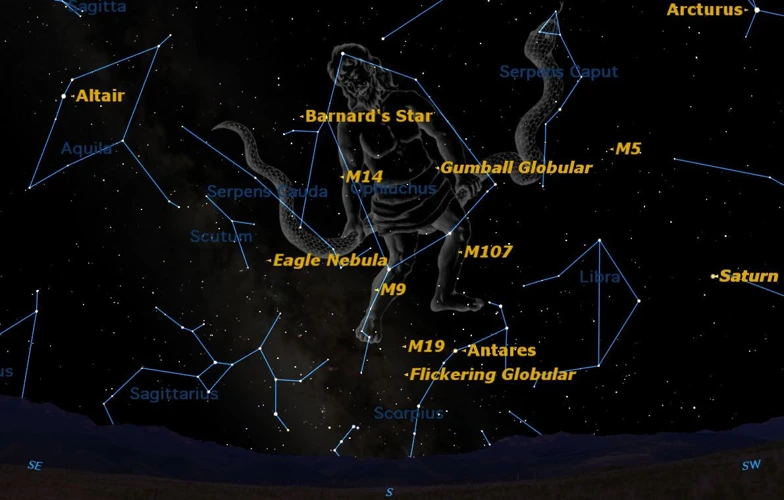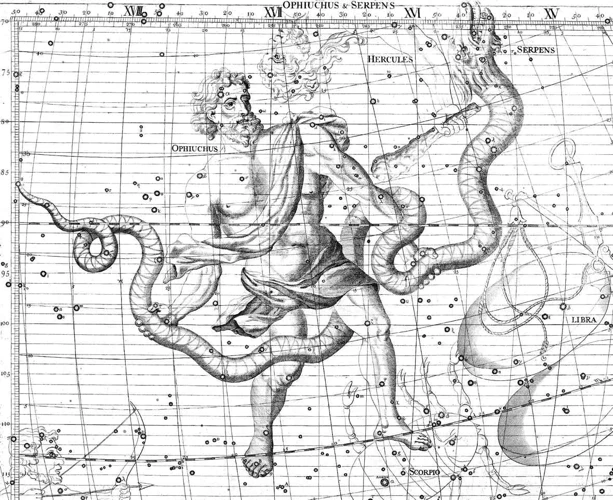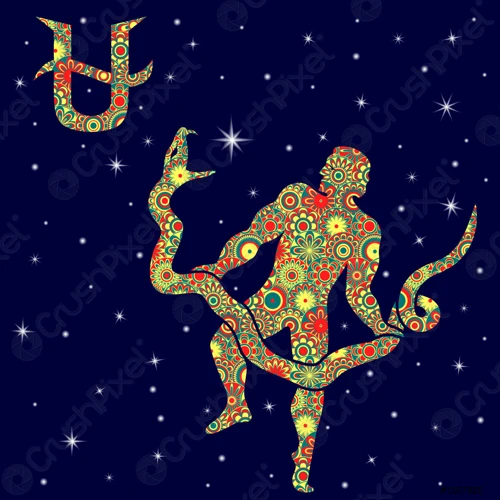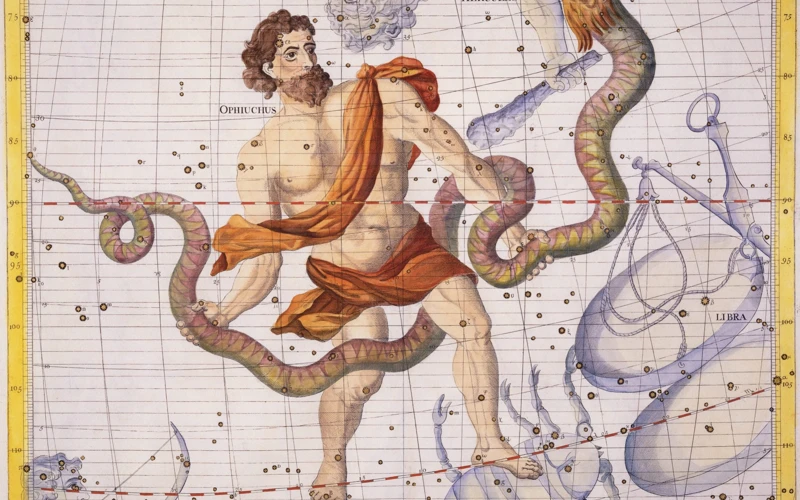The Ophiuchus Constellation: Unraveling its Mysteries
The night sky has always fascinated humanity as we gaze up at the celestial wonders above. Among the countless constellations dotting the heavens, Ophiuchus stands out as both enigmatic and awe-inspiring. Its mythological origins and unique astronomical position have captivated astronomers and stargazers alike. In this article, we will delve into the fascinating facts surrounding the Ophiuchus constellation. From the intriguing story behind its name to its association with the Ophiuchids meteor shower, we will explore the mysteries and controversies that surround this celestial wonder. Join us on an illuminating journey as we unravel the secrets of Ophiuchus and shed light on its cultural significance throughout history.
Contents
- 1. The Ophiuchus Constellation
- 2. Unique Features
- 3. The 13th Zodiac Sign Controversy
- 4. Cultural Significance
- Conclusion
-
Frequently Asked Questions
- 1. What does the Ophiuchus constellation represent in mythology?
- 2. Where is the Ophiuchus constellation located in the night sky?
- 3. How did the Ophiuchus constellation get its name?
- 4. What are some notable stars in the Ophiuchus constellation?
- 5. What is the significance of the Ophiuchids meteor shower?
- 6. Did the Ophiuchus constellation play a role in ancient civilizations?
- 7. Is Ophiuchus considered the 13th zodiac sign?
- 8. How do astrologers interpret the Ophiuchus constellation in astrology?
- 9. How has the Ophiuchus constellation influenced modern astrology?
- 10. Can the Ophiuchus constellation be seen with the naked eye?
- References
-
Frequently Asked Questions
- 1. What does the Ophiuchus constellation represent?
- 2. Where is the Ophiuchus constellation located in the night sky?
- 3. What is the significance of the Ophiuchids meteor shower?
- 4. Is Ophiuchus considered the 13th zodiac sign?
- 5. What is the historical background of the 13th zodiac sign controversy?
- 6. How do astrologers interpret Ophiuchus in modern astrology?
- 7. Which ancient civilizations recognized the Ophiuchus constellation?
- 8. What other constellations are associated with the Ophiuchus constellation?
- 9. Are there any famous stars or deep-sky objects in the Ophiuchus constellation?
- 10. How can I locate the Ophiuchus constellation in the night sky?
- References
- Read More
1. The Ophiuchus Constellation

The Ophiuchus constellation, also known as the Serpent Bearer, is shrouded in both mythological lore and astronomical intrigue. Its name is derived from the Greek word “ophis,” meaning snake, symbolizing the serpents that are intertwined around the figure. Positioned near the celestial equator, Ophiuchus graces the night sky between the constellations of Scorpius and Hercules. With its distinct shape and prominent stars, such as Rasalhague and Barnard’s Star, this constellation has captured the curiosity of astronomers for centuries. Ophiuchus is also associated with the mesmerizing Ophiuchids meteor shower, which occurs annually in June. This celestial phenomenon brings a spectacular display of shooting stars, making it a must-see event for astronomy enthusiasts. The Ophiuchus constellation’s mystique and allure continue to fascinate stargazers, offering a glimpse into the wonders of the universe.
(Link to relevant article: /wrath-of-the-lion-legend-constellation-leo/)
1.1 Mythological Origins
In the realm of mythology, the origins of the Ophiuchus constellation are steeped in captivating stories and legends. One of the most prominent tales associated with this constellation is the myth of Asclepius, the Greek god of healing. Asclepius was known for his remarkable ability to revive the dead, which brought concerns to the mighty gods of Olympus. In order to maintain the balance between life and death, Zeus, the king of gods, struck Asclepius with a thunderbolt, taking his life. To honor his immense power and contribution, Zeus immortalized Asclepius by placing him among the stars, forming the constellation Ophiuchus, the Serpent Bearer. In some renditions of the myth, the serpent coiled around Ophiuchus represents the staff of Asclepius, a symbol of medical healing recognized to this day. The mythological origins of Ophiuchus not only highlight the significance of healing and medical prowess but also add a sense of mystique to this celestial formation.
(relevant link: /unveiling-crab-nebula-mystery/)
1.2 Astronomical Position
| The Ophiuchus constellation holds a fascinating astronomical position in the night sky. With its location near the celestial equator, Ophiuchus is visible from both the Northern and Southern Hemispheres, making it a truly global constellation. It is bordered by several well-known constellations, including: |
|
Ophiuchus intersects the ecliptic, the apparent path of the Sun across the sky, making it one of the thirteen constellations through which the Sun passes during the year. This intersection has led to debates regarding the inclusion of Ophiuchus as a zodiac sign and its influence on astrological interpretations. Its position in the night sky makes it easily recognizable and adds to the allure and significance of this celestial marvel.
(Link to relevant article: /cracking-code-libra-scorpio-compatibility/)
2. Unique Features

The Ophiuchus constellation boasts several unique features that make it stand out among other constellations in the night sky. One of its most distinctive characteristics is its association with the Serpent Bearer, a figure depicted as holding a serpent. This imagery reflects the mythological origins of Ophiuchus and adds a sense of intrigue to its presence in the celestial realm. Additionally, Ophiuchus is connected to the Ophiuchids meteor shower, an annual event that dazzles observers with its spectacular display of shooting stars. This meteor shower, named after the constellation, offers a breathtaking experience for those lucky enough to witness it. The combination of its mythological roots and its connection to a captivating meteor shower makes the Ophiuchus constellation truly unique and captivating.
2.1 The Serpent Bearer
The Serpent Bearer is a significant aspect of the Ophiuchus constellation, symbolizing both healing and wisdom. The figure in the constellation is often depicted as a man holding a snake, representing the Greek mythological figure of Asclepius, the god of medicine. Asclepius was known for his remarkable healing abilities, and his association with the snake is believed to stem from ancient traditions that considered these creatures as symbols of rebirth and renewal. In Greek mythology, it is said that Asclepius was taught the art of healing by the wise centaur Chiron. His remarkable healing skills became so renowned that Hades, the god of the underworld, grew fearful and persuaded Zeus to strike him down with a lightning bolt. Out of respect for Asclepius’s contributions to humanity, Zeus then immortalized him in the night sky as the constellation Ophiuchus, forever carrying the serpent. The symbolism behind the Serpent Bearer reflects the connection between medicine, wisdom, and the eternal cycle of life and death. It serves as a reminder of the healing potential and the pursuit of knowledge that transcends human limitations.
2.2 Ophiuchids Meteor Shower
The Ophiuchids meteor shower is a celestial spectacle that occurs annually in the month of June. Named after the Ophiuchus constellation, from which it originates, this meteor shower offers a captivating display of shooting stars streaking across the night sky. What makes the Ophiuchids meteor shower unique is its association with the debris left behind by Comet 26P/Grigg-Skjellerup. As Earth passes through the remnants of this comet’s tail, the particles burn up in our atmosphere, creating the mesmerizing streaks of light that we observe as meteors.
With an average peak rate of about 5 to 15 meteors per hour, the Ophiuchids meteor shower is a relatively modest meteor shower compared to other well-known showers such as the Perseids or the Leonids. However, what sets it apart is its unpredictable nature. The Ophiuchids meteor shower is known for its sporadic outbursts, where the number of meteors dramatically increases for a short period, creating a spectacle that astonishes and delights observers.
To witness the Ophiuchids meteor shower, finding a location away from light pollution is crucial. Rural areas or dark sky reserves are ideal for enjoying the full magnitude of this celestial event. Despite its relatively lower activity compared to other meteor showers, dedicated sky gazers are rewarded with the opportunity to witness the magic of shooting stars radiating from the radiant point in the Ophiuchus constellation.
The Ophiuchids meteor shower provides a unique opportunity for astronomy enthusiasts and stargazers to marvel at the wonders of the universe. The unpredictable outbursts and the association with the Ophiuchus constellation make it a captivating event that shouldn’t be missed.
(No relevant anchor for internal link)
3. The 13th Zodiac Sign Controversy

The 13th Zodiac sign controversy has ignited numerous debates among astrologers and astronomy enthusiasts. Traditionally, there have been 12 zodiac signs that correspond to the Earth’s orbit around the Sun. However, the discovery of the constellation Ophiuchus has raised questions about the inclusion of a 13th zodiac sign. While the concept of Ophiuchus as a new zodiac sign gained popularity in recent years, it is important to consider the historical background of astrology. Since ancient times, astrology has been based on the 12 zodiac signs as defined by the Babylonians and later adopted by the Greeks. The addition of a 13th sign would shift the entire zodiac system, affecting the interpretation of birth charts and astrology readings. While some astrologers embrace the idea of Ophiuchus as the 13th sign, others maintain that it is a constellation separate from the zodiac. The controversy surrounding the 13th zodiac sign adds a fascinating layer to the study of astrology, prompting discussions about the impact of new discoveries on ancient traditions.
3.1 Historical Background
The historical background of the Ophiuchus constellation is steeped in ancient mythology and cultural significance. Dating back thousands of years, this constellation has been observed and studied by various civilizations throughout history. In Greek mythology, Ophiuchus is associated with the legendary figure of Asclepius, the son of Apollo and the god of medicine. Asclepius was known for his exceptional healing abilities and was often depicted holding a staff with a single serpent coiled around it, which eventually became the symbol of medicine. This connection to healing and medicine made Ophiuchus a prominent figure in ancient Greek culture. In Egyptian mythology, the constellation was linked to Imhotep, a revered figure who was believed to be a healer and a polymath. The historical background of the Ophiuchus constellation showcases its significance in various ancient civilizations and highlights its association with healing and wisdom. It is through these historical references that we gain insight into the profound impact this constellation had on past cultures.
3.2 Astrological Interpretations
Astrological interpretations of the Ophiuchus constellation remain a subject of controversy and debate. Traditionally, the zodiac consisted of twelve signs, each representing a specific period of the year. However, the discovery and inclusion of Ophiuchus as a thirteenth zodiac sign have shaken the foundation of astrological beliefs. Astrologers who incorporate Ophiuchus see it as a sign representing healing, wisdom, and transformation. Individuals born under Ophiuchus are said to possess traits such as a profound connection with spirituality, strong intuition, and the ability to bridge gaps between the physical and spiritual realms. However, skeptics argue that the inclusion of Ophiuchus disrupts the longstanding astrological system and dilutes the significance of the traditional twelve signs. They argue that the ancient interpretations and characteristics attributed to the twelve signs should not be altered or influenced by the addition of a new sign. Regardless of one’s stance, the astrological interpretations of Ophiuchus continue to intrigue those seeking a deeper understanding of the role of astrology in their lives.
(No relevant anchor in the text)
4. Cultural Significance

Throughout history, the Ophiuchus constellation has held profound cultural significance in various civilizations. In ancient times, the constellation was associated with healers and medicine, as the figure of Ophiuchus was often depicted as a serpent bearer and symbolized the god of medicine, Asclepius. Ancient civilizations such as the Greeks and Egyptians revered the healing powers associated with Ophiuchus, and temples were built in honor of this celestial figure. In modern astrology, the inclusion of Ophiuchus as the thirteenth zodiac sign has sparked controversy and debate. While some astrologers incorporate Ophiuchus into their practice, it remains on the fringes of mainstream astrology. Nonetheless, its presence continues to intrigue astrologers and stargazers worldwide, adding another layer to the tapestry of celestial significance. The cultural significance of Ophiuchus showcases the enduring fascination and influence of the stars on human civilization.
4.1 Ancient Civilizations
Ancient civilizations across the world held a deep reverence for the stars and constellations, and the Ophiuchus constellation was no exception. In the Babylonian culture, Ophiuchus was associated with the god Enki, who was revered as a healer and the bringer of knowledge and civilization. The Egyptians linked this constellation with Imhotep, a revered figure known as the father of medicine and architecture. Imhotep was worshipped as a divine healer and was believed to possess great wisdom and knowledge. In Greek mythology, Ophiuchus was often associated with the legendary healer, Asclepius. Asclepius was known for his exceptional healing abilities and was eventually transformed into a constellation by the gods. The influence of ancient civilizations on the significance of the Ophiuchus constellation cannot be understated, as it demonstrates the universal admiration for healing and wisdom across cultures and time. The cultural significance of Ophiuchus in ancient civilizations underscores its enduring impact on human beliefs and the connection between the celestial and earthly realms.
(List of keywords: Ophiuchus constellation, ancient civilizations, Babylonian culture, god Enki, healer, bringer of knowledge, civilization, Egyptians, Imhotep, father of medicine, architecture, divine healer, wisdom, Greek mythology, Asclepius, healing abilities, constellation, gods, universal admiration, healing, wisdom, cultural significance, enduring impact, celestial, earthly realms.)
4.2 Modern Astrology
Modern astrology has not been immune to the controversy surrounding the Ophiuchus constellation. While traditionally, astrology has recognized twelve zodiac signs, the addition of Ophiuchus as the thirteenth sign has sparked debates among astrologers and enthusiasts. Some argue that Ophiuchus should be included in the zodiac system, highlighting its alignment with the Sun during a specific period of the year. Those who advocate for its inclusion suggest that Ophiuchus represents individuals born between November 30th and December 17th. They attribute unique traits and characteristics to people born under this sign, emphasizing their potential for healing and the pursuit of knowledge. However, critics argue that adding a new zodiac sign would disrupt the established astrological framework and raise questions about the accuracy and reliability of horoscopes. Traditionalists maintain that the twelve zodiac signs have served astrology well for centuries and should not be altered. Despite the controversy, Ophiuchus has gained popularity in recent years, and some individuals resonate with its symbolism and identify themselves with the serpent bearer. Modern astrology continues to evolve, and the inclusion or exclusion of Ophiuchus remains a topic of debate in astrological circles.
Conclusion

The Ophiuchus constellation holds a special place in the vast expanse of the night sky, captivating our imagination through its mythological origins, astronomical position, unique features, and cultural significance. From the ancient civilizations that revered this constellation as a symbol of healing and wisdom to the controversies surrounding its status as the 13th zodiac sign, Ophiuchus has sparked curiosity and debate throughout history. Today, modern astrology has embraced the Ophiuchus constellation, considering it as a potential addition to the traditional zodiac. While the Ophiuchus constellation may remain a mystery to some, its presence in the celestial realm continues to inspire and intrigue astronomers, astrologers, and stargazers alike. It serves as a reminder of the vastness and beauty of our universe, urging us to explore, question, and appreciate the wonders that lie beyond our earthly existence. Whether you are an astronomy enthusiast, a believer in astrology, or simply someone mesmerized by the wonders of the cosmos, the Ophiuchus constellation offers a glimpse into the secrets of the night sky, leaving an indelible mark on our collective fascination with the stars above.
Frequently Asked Questions

1. What does the Ophiuchus constellation represent in mythology?
In Greek mythology, Ophiuchus is often associated with the legendary figure of Asclepius, the god of medicine. According to the myth, Asclepius possessed the power to resurrect the dead. The serpents in the constellation symbolize the snakes that played a significant role in Asclepius’ mythological story.
2. Where is the Ophiuchus constellation located in the night sky?
Ophiuchus can be found near the celestial equator, sandwiched between the constellations of Scorpius and Hercules. Its position allows for easy visibility in certain parts of the world during different seasons.
3. How did the Ophiuchus constellation get its name?
The name “Ophiuchus” comes from the Greek word “ophis,” which means snake. This name was given to the constellation due to its distinctive shape, resembling a figure holding a snake.
4. What are some notable stars in the Ophiuchus constellation?
The Ophiuchus constellation boasts several notable stars, including “Rasalhague,” a bright binary star system in close proximity to the head of the constellation. Another notable star is “Barnard’s Star,” one of the closest known stars to our solar system.
5. What is the significance of the Ophiuchids meteor shower?
The Ophiuchids meteor shower is associated with the dust particles left behind by Comet 26P/Grigg-Skjellerup. This annual meteor shower occurs in June, offering a captivating display of shooting stars originating from the direction of the Ophiuchus constellation.
6. Did the Ophiuchus constellation play a role in ancient civilizations?
Yes, the Ophiuchus constellation held significance in various ancient civilizations. It was often associated with healing and medicine due to its connection to the mythological figure of Asclepius. Many cultures regarded this constellation as a symbol of knowledge and wisdom.
7. Is Ophiuchus considered the 13th zodiac sign?
Ophiuchus is not officially recognized as a zodiac sign in Western astrology. However, its position on the ecliptic has sparked debates and controversies regarding its inclusion as a 13th zodiac sign.
8. How do astrologers interpret the Ophiuchus constellation in astrology?
Some astrologers who incorporate the 13th zodiac sign interpret those born under Ophiuchus as creative, intuitive, and possessing healing abilities. However, these interpretations are not universally accepted and vary among astrological practitioners.
9. How has the Ophiuchus constellation influenced modern astrology?
While Ophiuchus is not officially recognized in Western astrology, its existence has sparked discussions and debates within the astrological community. Some astrologers incorporate Ophiuchus into their practice, expanding the traditional zodiac system.
10. Can the Ophiuchus constellation be seen with the naked eye?
Yes, the Ophiuchus constellation is visible with the naked eye under clear, dark skies. Its distinct shape and prominent stars make it relatively easy to identify, adding to the wonder and fascination of stargazers worldwide.
References
Frequently Asked Questions

1. What does the Ophiuchus constellation represent?
The Ophiuchus constellation represents a mythical figure known as the Serpent Bearer. In Greek mythology, Ophiuchus was associated with healing and medicine.
2. Where is the Ophiuchus constellation located in the night sky?
The Ophiuchus constellation can be found between the constellations of Scorpius and Sagittarius. It is best visible in the northern hemisphere during the summer months.
3. What is the significance of the Ophiuchids meteor shower?
The Ophiuchids meteor shower is a lesser-known meteor shower that occurs in mid-June each year. It is associated with the dust trail left by the comet 26P/Grigg-Skjellerup.
4. Is Ophiuchus considered the 13th zodiac sign?
While Ophiuchus is sometimes referred to as the 13th zodiac sign, it is not officially recognized in Western astrology. The traditional zodiac consists of 12 signs.
5. What is the historical background of the 13th zodiac sign controversy?
The controversy surrounding the 13th zodiac sign dates back to ancient Babylonian astrology. The Babylonians developed a 12-sign zodiac based on the constellations that aligned with the Sun throughout the year.
6. How do astrologers interpret Ophiuchus in modern astrology?
In modern astrology, some astrologers include Ophiuchus as a separate zodiac sign. Those who follow this interpretation believe that individuals born between November 29 and December 17 fall under the sign of Ophiuchus.
7. Which ancient civilizations recognized the Ophiuchus constellation?
The Ophiuchus constellation was recognized by various ancient civilizations, including the Greeks, Egyptians, and Babylonians. Each civilization had different myths and interpretations associated with the constellation.
8. What other constellations are associated with the Ophiuchus constellation?
Within the Ophiuchus constellation, there are several other notable constellations and celestial objects, including Serpens Caput, Serpens Cauda, and Barnard’s Star.
9. Are there any famous stars or deep-sky objects in the Ophiuchus constellation?
Yes, the Ophiuchus constellation is home to several famous stars and deep-sky objects. One of the most well-known is Rasalhague, a binary star system located in the head of Ophiuchus.
10. How can I locate the Ophiuchus constellation in the night sky?
To locate the Ophiuchus constellation, one can look for the distinctive shape of a man holding a serpent. It is best seen during the summer months and can be found near the bright stars Antares and Vega.
References
- Ophiuchus: Facts about the Snake Bearer
- Ophiuchus Constellation – Facts & Features – The Planets
- Ophiuchus Constellation Myths and Facts







